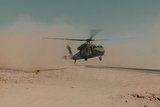Ukraine gets new Trinity drone donation from Quantum Systems
Quantum Systems' Trinity drone has been used to report war damage and guide humanitarian aid provision. (Photo: Quantum Systems)
German drone manufacturer Quantum Systems has donated 100 of its Trinity drones to Ukraine, for the purposes of disaster relief, damage assessment, and surveying.
On July 31st, as the world reported that Ukraine had been hit overnight by 89 Iranian-made explosive drones, the first 28 of the hundred Trinity mapping drones were presented to Vitali Klitschko, mayor of Kyiv.
The Trinity drones are electrically powered fixed-wing mapping UAVs based on the commercial Trinity F90+. They can be carried in a single rucksack, have vertical take-off and landing (VTOL) capabilities, and can host a range of payloads. Traditionally, they are equipped with a 61 Megapixel Sony RGB camera for high-quality-image capture and surveying functions, although they can also be fitted with multi-spectral cameras and LiDAR sensors.
Shephard Defence Insight has estimated a gross unit cost of US$80,000 per drone, meaning the donation in total would be equivalent to around $800,000 of drone technology from an individual manufacturer, rather than a national government or an international organisation.
The Trinity drone uses a configuration borrowed from Quantum’s Vector drone, which Ukraine has used extensively since the invasion by Russia began. The main feature of the Vector is its 2-in-1 design, which allows it to transform from a fixed-wing to a tri-copter, depending on the operational requirements of its mission.
Ukraine has proved the main theatre of operations for both the Vector and the Trinity in recent years, and many of the drones have been donated through third-party nations to aid Ukraine in its efforts to map the effects of Russian bombardments.
Similarly, the newly donated Trinity drones are reaching the country through the German charitable foundation, #WeAreAllUkrainians.
Like many of the previous Quantum drones that have been put to work in Ukraine, the latest hundred donated will be used for disaster relief, damage assessment and surveying of the country’s changing urban landscape.
Parts of this report were supplied by Shephard Defence Insight.
Related Programmes in Defence Insight
More from Uncrewed Vehicles
-
![What's next for the Pentagon after the Replicator programme?]()
What's next for the Pentagon after the Replicator programme?
Although the Replicator initiative has made several accomplishments, there are still multiple gaps to plug across the US Department of Defense (DoD) and its services.
-
![Cummings Aerospace showcases Hellhound loitering munition designed for US Army’s LASSO programme (video)]()
Cummings Aerospace showcases Hellhound loitering munition designed for US Army’s LASSO programme (video)
Cummings Aerospace presented its turbojet-powered Hellhound loitering munition at SOF Week 2025, offering a man-portable solution aligned with the US Army’s LASSO requirements.
-
![SOF Week 2025: PDW unveils attritable FPV drone for SOF operations at scale]()
SOF Week 2025: PDW unveils attritable FPV drone for SOF operations at scale
PDW has revealed its Attritable Multirotor First Person View drone at SOF Week 2025, offering special operations forces a low-cost, rapidly deployable platform for strike and ISR missions, inspired by battlefield lessons from Ukraine.
-
![SOF Week 2025: Teledyne FLIR white paper provides guidance on reusable loitering munitions]()
SOF Week 2025: Teledyne FLIR white paper provides guidance on reusable loitering munitions
Teledyne FLIR is highlighting the emerging requirements for 'recoverable and re-usable' loitering munitions across the contemporary operating environment during this week’s SOF Week conference in Tampa, Florida.
-
![SOF Week 2025: Kraken Technology group debuts K3 Scout USV in North America]()
SOF Week 2025: Kraken Technology group debuts K3 Scout USV in North America
High-performance maritime industry player Kraken Technology Group, based in the UK, has used the SOF Week conference in Tampa, Florida this week to debut its K3 Scout uncrewed surface vessel (USV) to the North American market.
-
![Palladyne AI and Red Cat to demonstrate capabilities for autonomous drone swarms to the US military]()
Palladyne AI and Red Cat to demonstrate capabilities for autonomous drone swarms to the US military
Red Cat and Palladyne AI recently conducted a cross-platform collaborative flight involving three diverse heterogeneous drones.

























